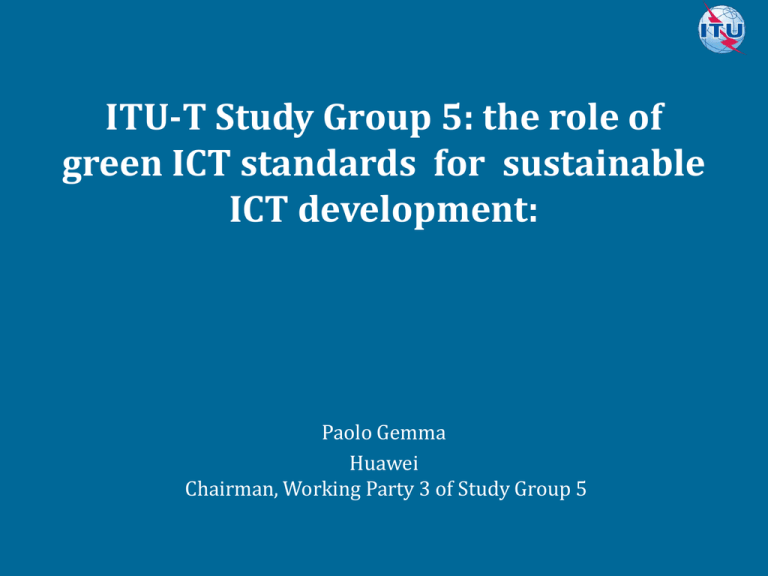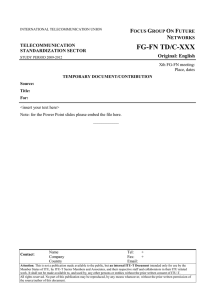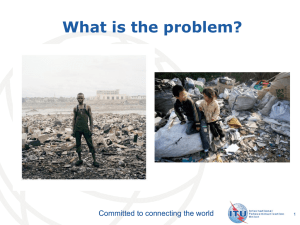ITU-T Study Group 5: the role of ICT development: Paolo Gemma
advertisement

ITU-T Study Group 5: the role of green ICT standards for sustainable ICT development: Paolo Gemma Huawei Chairman, Working Party 3 of Study Group 5 Committed to connecting the world Working Party 3 (WP3/5) ICT and climate change Work areas: Q13/5 - Environmental impact reduction including e-waste Q14/5 - Setting up a low cost sustainable telecommunication infrastructure for rural communications in developing countries Q15/5 - ICTs and adaptation to the effects of climate change Q16/5 - Leveraging and enhancing the ICT Environmental sustainability Q17/5 - Energy efficiency for the ICT sector and harmonization of environmental standards Q18/5 - Methodologies for the assessment of environmental impact of ICT Q19/5 - Power feeding systems Committed to connecting the world Facts about e-waste worldwide There were 2.37 million tons of electronics discarded in 2013 about 7kg for every person on the planet Only 8% of old cell phones are recycled properly Only 12.5% of e-waste is recycled Recycling one million laptops saves enough energy to power 3,600 homes Committed to connecting the world Question 13/5 Environmental impact reduction including e-waste Main study area: ensure the safety and environmental performance associated with ICT products, equipment and facilities, including the avoidance of hazardous materials and final disposal through standards ensure that the ICT products, equipment and facilities cause minimum environmental and health impact minimize the effect on the environment of existing and new products under development and especially the resulting e-waste mitigate e-waste and reduce negative environmental and health impact like potential GHG emissions from uncontrolled handling through proper and environmentally responsible recycling Committed to connecting the world Question 13/5 Environmental impact reduction including e-waste Main Tasks: Develop Recommendations in the in the field of e-waste mitigation/minimization Motivate ITU members to share their national experiences and spread the collected knowledge related to environmental and sustainability aspects of laws or directives Determine processes to minimize the environmental (including health) impact of products (materials, hazardous materials avoidance), manufacturing processes, operational procedures and disposal; Committed to connecting the world Deliverables under study E-waste Rare metal Technical report on life-cycle management of ICT equipment Implementation guide on e-waste management Supplement on Best practices on ewaste management in developing countries including information on country success stories Test suites for assessment of the External universal power adapter solutions for stationary/portable information and communication technology device A printing label format to provide rare metals information of ICT goods Due diligence Implementation guidelines for ICT supply chains due diligence on conflict minerals Due Diligence Guidelines for Conflict Metals (Supply Title: Technical guidelines towards exercising due diligence when handling conflict minerals) Contributions are welcomed! Take part intoour discussions Committed connecting the world Highlights on deliverables Power supply series Recommendation ITU-T L.1000: Universal power adapter and charger solution for mobile terminals and other hand-held ICT devices: Saves 82,000 tons of e-waste per year Saves at least 13.6 MtCO2 emissions annually Recommendation ITU-T L.1001: External universal power adapter solutions for stationary information and communication technology devices: Saves 300,000 tons of e-waste per year Reduces the energy consumption and GHG emissions of external power supplies by between 25% and 50% Committed to connecting the world Highlights on deliverables Power supply series Recommendation ITU-T L.1002: External universal power adapter solutions for portable information and communication technology devices: Reduces e-waste, optimizing the use of scarce and raw materials and allowing for reuse Recommends design for MTBF 50.000 hours of active use Increases usability Recommendation ITU-T L.1005: Test suites for assessment of the universal charger solution: Describes specific test suites applicable to the universal charger solution defined in ITU-T L.1000 (assesses energy efficiency, interworking, safety and EMC) Committed to connecting the world Energy is not inexhaustible, as natural resources are not infinite We need to transform our daily behavior, envisioning ambitious goals for a sustainable future Change is possible, but can’t wait… … we need to act right now! Photo credit: leadchangegroup.com Committed to connecting the world Question 17/5 Energy efficiency for the ICT sector and harmonization of environmental standards Main study area: Definition of measurement methods, metrics/KPI and reference values for different technologies Sharing of best practices for ICT’s energy efficiency enhancements Analysis of the most energy efficient architectures and solutions in support of smart grids Complement and harmonize ICT and environmental standards developed by other ITU Study Groups and Standardization Bodies Committed to connecting the world Question 17/5 Energy efficiency for the ICT sector and harmonization of environmental standards Main Tasks: Develop Recommendations in the in the field of energy efficiency Develop best practices and best reference cases Provide and maintain an overview of key mitigation technologies Coordinate with other ITU Study Groups and other bodies on a regular basis to ensure closest alignment Committed to connecting the world Highlights on deliverables Recommendation ITU-T L.1300rev - Best practices for green data centers Recommendation ITU-T L.1310rev - Energy efficiency metrics and measurement for TLC equipment Recommendation ITU-T L.1320 - Energy efficiency metrics and measurement for power and cooling equipment for telecommunications and data centres Recommendation ITU-T L.1340 - Informative values on the energy efficiency of telecommunication equipment Committed to connecting the world Highlights on deliverables ITU-T L.1300 Best practices for green data centres For example, applying best practices to cooling could reduce the energy consumption of a typical data centre by more than 50%. Best practices related to optimum design and construction Efficient use and management of data centres, taking into account both power and cooling equipment Committed to connecting the world Highlights on deliverables ITU-T L.1310 Energy efficiency metrics and measurement methods for telecommunication equipment Metrics and measurement methods defined for broadband wireline/wireless equipment and small networking devices These metrics allow for comparisons of equipment within the same class (e.g. equipment using the same technologies) Committed to connecting the world Highlights on deliverables ITU-T L.1320 Energy efficiency metrics and measurement for power and cooling equipment for telecommunications and data centres Metrics and measurement methods defined for Power system DC and AC, Cooling equipment and renewable system These metrics allow for comparisons of equipment within the same class (e.g. equipment using the same technologies) Air conditioner indoor unit Temperature and humidity sensor L.1320(14)_FII.1 Current probe Voltage testing point Voltage testing point Current probe L1 L2 L3 AC UPS Load N Committed to connecting the world Power meter L.1320(14)_F02 Highlights on deliverables Supplement on energy efficiency for telecommunication equipment This Supplement reviews the conceptstofor EE in application Committed connecting the world to networking devices Deliverables under study L.DC minimum set - Minimum L. ene ICT serv - Assessment of data set and communication energy consumption of interface requirements for Data telecommunication services Center energy management L. Model EE ICT - Reference L.M&M_Networks - Energy operational model and interface efficiency measurement and for improving energy efficiency metrics for telecommunication of ICT network devices network EE for Smart Grid - Analysis of L.assDC - Assessment of energy the energy efficiency of efficiency on infrastructure in telecommunication services data center and telecom center used for the needs of smart grid L.NET_Infra_assessment - Total applications network infrastructure Energy L.std TandT in EE efficiency metrics Standardization terms and L.RBS_assesment - Energy trends in energy efficiency efficiency metrics of mobile station cell site and best practice for energy saving Committed to connecting the world New activities proposed in Kochi L. Green STNI - Green ICT solutions for telecom network infrastructure L.EE-ARCH - Energy efficient architectures of ICT systems Committed to connecting the world Additional information ITU-T/SG5 “Environment & Climate Change” itu.int/go/tsg5 ITU-T and Climate Change itu.int/go/ITU-T/climate THANK YOU! tsbsg5@itu.int Committed to connecting the world



